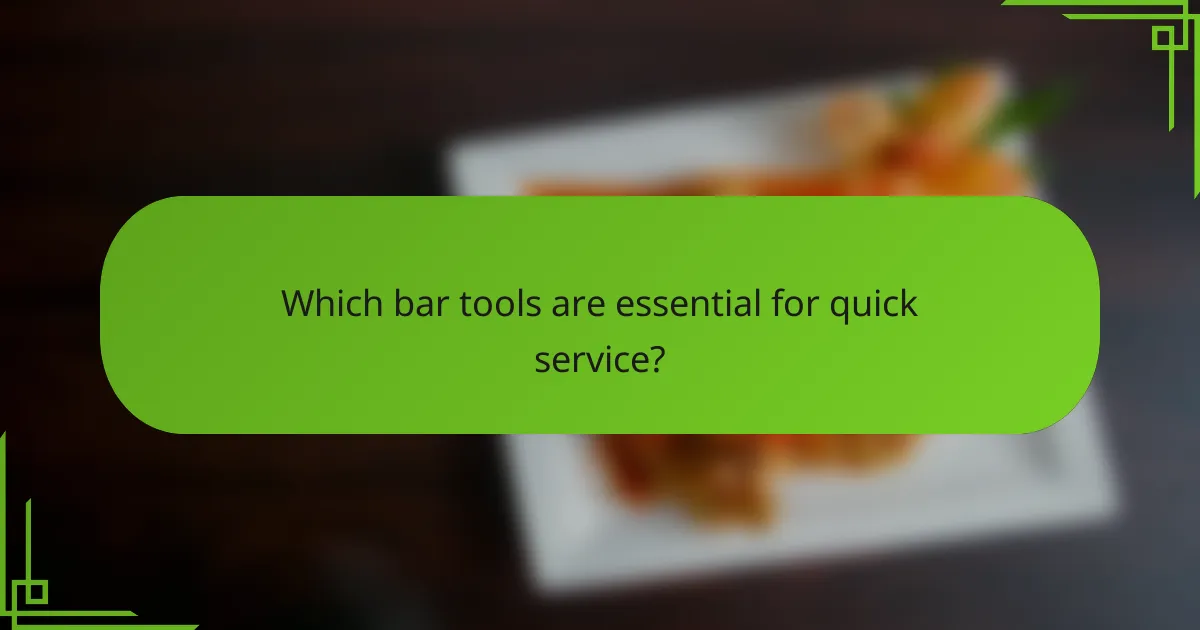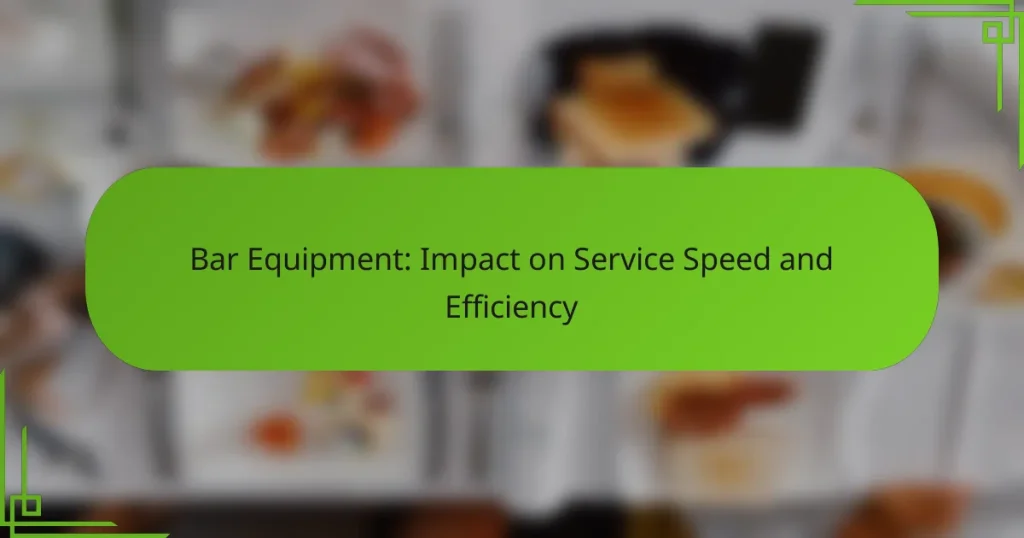Effective bar equipment plays a crucial role in enhancing service speed and efficiency, allowing bartenders to prepare drinks and process orders swiftly. By utilizing high-capacity ice machines, automated cocktail dispensers, and essential tools like speed pourers and shakers, bars can significantly reduce customer wait times and improve overall satisfaction.

How does bar equipment affect service speed in restaurants?
Bar equipment significantly impacts service speed by streamlining drink preparation and order processing, leading to quicker customer service. Efficient tools can reduce wait times and enhance overall operational flow, ultimately improving customer satisfaction.
Faster drink preparation with blenders
Blenders are essential for quickly preparing a variety of drinks, especially smoothies and cocktails that require ice and other ingredients to be mixed thoroughly. High-performance blenders can produce consistent results in low seconds, allowing bartenders to serve drinks faster during peak hours.
When selecting blenders, consider models with multiple speed settings and durable blades. Investing in commercial-grade blenders can also minimize downtime due to equipment failure, ensuring a steady service pace.
Efficient order processing with POS systems
Point of Sale (POS) systems streamline order processing by allowing bartenders to input orders quickly and accurately. Modern POS systems often feature touch screens and integrated payment options, reducing the time spent on transactions and minimizing errors.
Choose a POS system that integrates with inventory management and staff scheduling to enhance efficiency. Training staff on the system can further reduce service time, as familiarity with the technology leads to quicker order handling.
Streamlined workflow with modular bar setups
Modular bar setups enable a flexible and organized workspace, allowing bartenders to access tools and ingredients efficiently. This layout can significantly reduce movement and time spent searching for items, which is crucial during busy service periods.
Consider implementing designated stations for different tasks, such as mixing, garnishing, and serving. This separation helps maintain a smooth workflow and can lead to faster service, as each bartender can focus on their specific role without unnecessary interruptions.

What types of bar equipment enhance efficiency?
Bar equipment that enhances efficiency includes high-capacity ice machines, automated cocktail dispensers, and multi-functional glass washers. These tools streamline operations, reduce wait times, and improve overall service quality.
High-capacity ice machines
High-capacity ice machines are essential for bars that serve a large volume of drinks. They produce ice quickly and in significant quantities, ensuring that bartenders have a steady supply for cocktails and other beverages. Look for machines that can produce hundreds of pounds of ice per day to meet peak demand.
When selecting an ice machine, consider energy efficiency and ease of maintenance. Models with built-in cleaning cycles can save time and ensure consistent ice quality. Additionally, ensure the machine fits within your bar’s space and complies with local health regulations.
Automated cocktail dispensers
Automated cocktail dispensers allow bartenders to serve drinks quickly and consistently. These systems mix ingredients precisely, reducing the chance of human error and speeding up service during busy hours. They can be programmed for various recipes, making it easy to offer a diverse drink menu.
Investing in a cocktail dispenser can significantly reduce labor costs and improve customer satisfaction. However, ensure that staff are trained to operate the system effectively and maintain it regularly to avoid downtime.
Multi-functional glass washers
Multi-functional glass washers streamline the cleaning process, allowing bars to maintain a steady supply of clean glassware. These machines can wash, rinse, and sanitize glasses in a matter of minutes, which is crucial during peak service times.
When choosing a glass washer, consider its capacity and cycle time. Models that can handle various glass types and sizes will provide the most flexibility. Regular maintenance is key to ensuring optimal performance and longevity of the equipment.

Which bar tools are essential for quick service?
Essential bar tools for quick service include speed pourers, jiggers, and shakers. These tools help bartenders serve drinks efficiently, ensuring accuracy and reducing wait times for customers.
Speed pourers for liquor bottles
Speed pourers are designed to allow a steady and controlled flow of liquor from the bottle, minimizing spills and waste. They typically fit snugly into the neck of liquor bottles and can dispense a shot in a matter of seconds.
When choosing speed pourers, consider the material and design. Plastic pourers are lightweight and affordable, while stainless steel options offer durability. A good quality speed pourer can improve service speed by up to 30% compared to traditional pouring methods.
Jiggers for precise measurements
Jiggers are essential for measuring spirits and mixers accurately, ensuring consistency in drink recipes. They typically come in two-sided designs, with one side measuring a standard shot (about 1.5 ounces) and the other for smaller amounts (like 0.5 ounces).
Using jiggers can significantly reduce overpouring, which not only saves money but also maintains the quality of cocktails. Bartenders should keep a few jiggers on hand to streamline the process and avoid delays during busy hours.
Shakers for rapid mixing
Shakers are crucial for mixing cocktails quickly and effectively, combining ingredients while chilling them. The most common types are Boston shakers and cobbler shakers, each offering unique advantages in speed and ease of use.
To maximize efficiency, bartenders should practice their shaking technique to minimize the time spent on each drink. A well-shaken cocktail can be prepared in under 10 seconds, making shakers a vital tool for high-volume service environments.

How can bar layout impact service speed?
A well-thought-out bar layout significantly enhances service speed by minimizing unnecessary movement and optimizing workflow. An efficient design allows bartenders to serve customers quickly, reducing wait times and improving overall customer satisfaction.
Efficient bar design reduces movement
Reducing movement is crucial for speeding up service in a bar. An efficient bar design positions frequently used items, such as glassware, mixers, and garnishes, within easy reach of bartenders. This setup minimizes the need for bartenders to walk back and forth, allowing them to focus on serving customers.
For instance, placing the ice bin and cocktail shaker close together can streamline the drink-making process. A well-organized workspace can cut down on service time by several seconds per drink, which adds up significantly during busy hours.
Strategic placement of equipment minimizes delays
Strategically placing equipment can greatly reduce delays in service. Key items like blenders, beer taps, and liquor bottles should be arranged in a logical order based on the most common drink orders. This approach allows bartenders to prepare drinks more efficiently without unnecessary interruptions.
Consider using a flowchart to visualize the most efficient layout for your bar. For example, position the beer taps at the end of the bar where patrons are likely to order them, while keeping cocktail ingredients nearby for faster access. This thoughtful arrangement can enhance service speed and improve customer experience.

What are the best practices for bar equipment maintenance?
Effective bar equipment maintenance is essential for ensuring service speed and efficiency. Regular upkeep not only prolongs the lifespan of equipment but also minimizes downtime and enhances customer satisfaction.
Regular cleaning schedules
Establishing regular cleaning schedules is crucial for maintaining bar equipment. Daily cleaning of surfaces and equipment helps prevent the buildup of grime and bacteria, which can affect both hygiene and performance. Consider implementing a checklist for daily, weekly, and monthly cleaning tasks.
For example, daily tasks might include wiping down countertops and cleaning glassware, while weekly tasks could involve deep cleaning machines like blenders and coffee makers. Monthly inspections should focus on equipment that requires more thorough maintenance, such as ice machines and draft lines.
Routine equipment checks
Conducting routine equipment checks is vital for identifying potential issues before they escalate. Regular inspections should include checking for leaks, ensuring that all components are functioning correctly, and verifying that safety features are operational. This proactive approach can significantly reduce the risk of equipment failure during peak service hours.
Establish a schedule for these checks, ideally aligning them with your cleaning routines. For instance, you might perform a detailed inspection of all equipment at the end of each week, allowing you to address any problems before the busy weekend rush.

How does technology improve bar service efficiency?
Technology enhances bar service efficiency by streamlining operations, reducing wait times, and improving order accuracy. By integrating various digital tools, bars can manage customer interactions and inventory more effectively, leading to a smoother service experience.
Mobile ordering systems
Mobile ordering systems allow customers to place orders directly from their smartphones, reducing the need for staff to take orders in person. This not only speeds up the ordering process but also minimizes errors that can occur during communication.
Bars can implement mobile ordering through dedicated apps or platforms, enabling customers to browse menus, customize orders, and make payments seamlessly. This technology can significantly decrease wait times during busy hours, enhancing overall customer satisfaction.
Inventory management software
Inventory management software helps bars track stock levels in real-time, ensuring that popular items are always available while minimizing waste. By automating inventory checks, bars can make informed purchasing decisions and reduce the risk of running out of key ingredients.
Effective inventory systems can alert staff when stock is low or when items are nearing expiration. This proactive approach allows bars to maintain optimal inventory levels, which is crucial for efficient service and cost management.
Customer relationship management tools
Customer relationship management (CRM) tools enable bars to collect and analyze customer data, enhancing service personalization. By understanding customer preferences and behaviors, bars can tailor promotions and improve overall engagement.
Implementing a CRM system can help bars track customer interactions, manage loyalty programs, and send targeted communications. This not only fosters customer loyalty but also drives repeat business, contributing to a more efficient service model.

What are the costs associated with upgrading bar equipment?
Upgrading bar equipment involves several costs, including the initial purchase price, installation fees, and ongoing maintenance expenses. These costs can vary significantly based on the quality and type of equipment chosen, as well as the specific needs of the bar.
Initial investment for high-quality tools
The initial investment for high-quality bar tools can range from a few hundred to several thousand dollars, depending on the equipment’s complexity and brand. Essential items like commercial blenders, ice machines, and draft systems typically represent the largest expenses.
When considering the initial investment, it’s crucial to evaluate the expected return on investment (ROI). High-quality equipment can enhance service speed and efficiency, potentially leading to increased sales and customer satisfaction.
To make informed decisions, create a budget that includes not just the purchase price but also installation and training costs. Prioritize equipment that aligns with your bar’s specific needs and expected volume of service.


